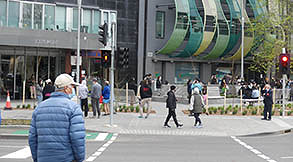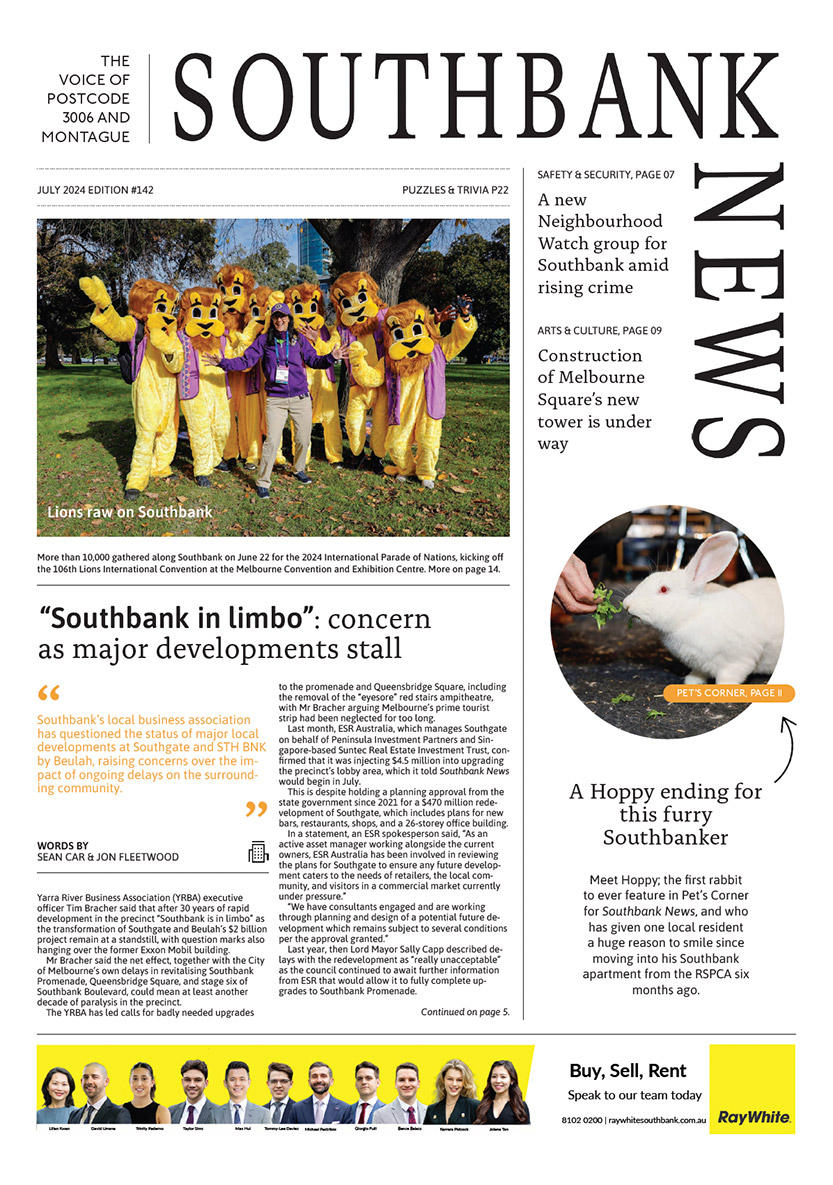Earthquakes and high-rise buildings: What you should know
By Matt Harvey
Residents took to the streets of Southbank as a magnitude 5.8 earthquake struck Victoria on September 22, with the shock event stunning many Melburnians.
According to the Seismology Research Centre this earthquake occurred 15 kilometres north-east of Woods Point, around 130 kilometres east of Melbourne.
This event was felt widely across Melbourne and as far away as Canberra and Sydney, while light shaking was reported in Adelaide and Launceston.
Wayne Peck of Seismology Research Australia was not too worried about the quake at that distance.
“Magnitude 5.8 which is a moderate sized earthquake by most standards, and you would generally not expect damage,” Mr Peck said.
Many aftershocks have been recorded, the largest of which was a magnitude 4.2 just over 15 minutes after the mainshock.
No significant damage outside of Melbourne was reported except for an exterior wall of a restaurant on Chapel St.
Though aftershocks could be coming for weeks afterwards, generally they’d be expected to be smaller.
What happened?
Earthquakes are relatively rare in Australia, or at least ones that people would pay attention to.
According to Geoscience Australia on average 100 earthquakes of magnitude three or more are recorded in Australia each year.
Earthquakes above a magnitude five occur on average every one-to-two years, and about every 10 years Australia experiences a potentially damaging earthquake of magnitude six or more.
Australia's largest recorded earthquake was in 1988 at Tennant Creek in the Northern Territory, with an estimated magnitude of 6.6.
A magnitude 6.5 earthquake at Meckering in 1968 caused extensive damage to buildings and was felt across most of southern Western Australia.
These earthquakes are two of the 11 that are recorded to have produced surface rupture in historical times, forming fault scarps like the one in Meckering.
Apart from causing shaking, earthquakes of magnitude four or greater can also trigger landslides.
In areas underlain by water-saturated sediments, large earthquakes, usually magnitude six or greater, may cause liquefaction.
The shaking causes the wet sediment to become quicksand and excessive movement from this can cause buildings to topple and the sediment might erupt at the surface from craters and fountains.
Undersea earthquakes can trigger a tsunami, or a series of waves which can cross an ocean and cause extensive damage to coastal regions.
Is my building safe?
As Australia doesn’t have a history of significantly damaging earthquakes, it has been slow to adapt to the needs of compensating for them.
According to Wayne Peck, an earthquake of similar magnitude in a more prepared location would produce very different results.
“So, an earthquake of that magnitude in a plate boundary area, or say somewhere like Wellington in New Zealand, you would probably expect no damage or very little damage because their buildings have, for a long while, been built to withstand earthquakes. Also, very old buildings have already collapsed in previous earthquakes. In Australia because we haven't got that history, buildings are actually more vulnerable to ground shaking,” Mr Peck said.
Professor John Wilson – an international expert in earthquake engineering and chairperson for the committee for earthquake loading standards in Australia – said Southbank was an interesting location structurally for building.
“The tricky part about Southbank is it is built on Coode Island silt so it's quite a sloppy foundation,” Professor Wison said.
According to the Australian Geomechanics society, Coode Island silt is a quaternary age alluvial deposit (loose clay, silt, sand, or gravel that has been deposited by running water in a stream bed, on a floodplain) of the Yarra River delta in Melbourne.
Professor Wilson said there were a number of factors to considers in relation to building safety in an Earthquake.
“Whenever you hear magnitude you need to understand how far away it is and, when we design buildings nowadays, new buildings have to be designed for about a magnitude six at 30kms in that order,” Professor Wilson said.
The distance of the earthquake meant people were safe, however, if a similar quake were to happen closer it may have been a different story.
“You might get a little bit of damage if it was a magnitude six at 30kms. At 20 to 30kms you might see some damage,” Professor Wilson said.
Since the Meckering earthquake in Western Australia, building design has been reconsidered across Australia.
“Up until that point in Australia we didn’t design for earthquakes. So then in the 1970s we put out an earthquake code and that was the first piece of design for earthquakes,” Professor Wilson said.
As Melbourne and Sydney hadn’t had any direct earthquakes there was still no design for earthquakes being implemented, according to Professor Wilson.
“Then in 1989 there was a Newcastle earthquake, magnitude 5.6 at about 20kms, a bit of a bullseye, and that caused a lot of damage in Newcastle,” Professor Wilson said.
“Then they revised the earthquake code so most cities, they had to start to design for earthquakes and we’ve been updating that code since.”
In June 2018, there was a major change to the building code and it was mandatory for every new building to be able to withstand a movement minimum threshold of 60 to 100mm per second.
Last month’s earthquake caused a movement of roughly five to 20mm per second.
However, the these changes only apply to buildings constructed after 2018, or if significant upgrades have occurred.
High-rise towers are built to withstand wind loads which provides added benefit when earthquakes strike.
“High-rises are pretty safe from that sort of thing,” Professor Wilson said. “When we design new buildings, we design for somewhere between 60 to 100mm per second.”
But as for the softness of Coode Island silt, Professor Wilson said this was a major consideration when designing buildings for riverside construction.
“When we designed for the 60 to 100mm, soft soil is more up to the 100 mark because soft soil tends to amplify the ground motions,” he said.
So, depending on where your building is constructed, how old it is, and if it has had any retrofitting done, there are plenty of measures in place to keep high-rise residents safe.
More surprisingly, it is low-rise buildings that are of greater concern to Professor Wilson.
“You find with earthquakes too the shorter buildings tend to amplify the ground motion, whereas your very tall buildings they sway very slowly, they sway too slowly to respond much to an earthquake,” he said.
According to Professor Wilson’s assessment, the most vulnerable were the masonry buildings, up to about two to three storeys, and then smaller buildings up to around five storeys.
Be sure to speak to your building manager and find out the details of your building, when was it built, and has it been upgraded.
What should I do?
This leaves the question of what to do if an earthquake strikes and the advice seems fairly consistent.
“The best thing to do is to shelter underneath a strong structure. If the worst thing does happen, you want to be protected from falling objects and hopefully get yourself into some sort of void,” Mr Peck said.
He added that standing in doorways or climbing under a stride table was generally considered the best thing to do while the quake was still happening.
“It's a strong point but certainly rushing outside is not a good thing to do because there is always the chance of something falling on top of you.”
Your building may ask you to evacuate, what should you do?
It is best to wait until the shaking has stopped before evacuating.
“Evacuations are fine but you want to make sure that once you are outside you are well clear of anything that could collapse on top of you, certainly with some of the older buildings in Melbourne if you've got a parapet or unsupported brick walls,” Mr Peck said.
However, being out in the street during the shaking is considered the worst place to be as there is an increased chance of danger from falling debris when the shaking has stopped.
“Then get out, but when you go out the door and under the awning do that really quickly, don’t dawdle,” Professor Wilson said.
“Then get out in the middle of the street but look out for cars!”

Sally Capp: one last chat as Lord Mayor of Melbourne







 Download the Latest Edition
Download the Latest Edition